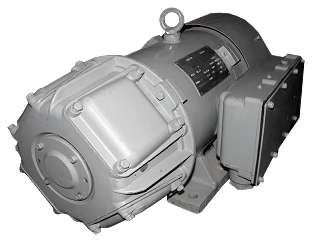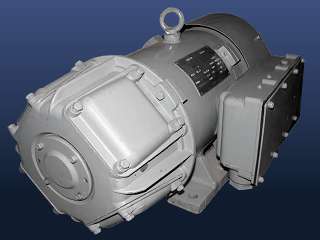Amplidyne

Figure 1: Russian Amplidyne "ЭМУ-50" with 3000 rpm and a maximum output power of 4 kW
Amplidyne
An Amplidyne is a high-powered amplifier constructed as a combination of a three-phase motor and a modified AC voltage generator. With an Amplidyne, large loads could be moved remote-controlled. The output power of an Amplidyne can be up to several 10 kilowatts with a power amplification of 104 bis 105.[1]
The Amplidyne was developed by the electrical engineer Ernst Alexanderson[2] during the Second World War. The name Amplidyne is a brand name of General Electric. It works as a regulated converter. A powerful motor as a three-phase synchronous machine is rigidly connected to a modified AC voltage generator. The motor rotates at a constant speed. The generator is equipped with DC-controlled field excitation. If the excitation voltage for the magnetic field in the generator is zero, no output voltage is generated at the generator, despite the fact that the motor operates at full speed. With just a few watts of power for the exciter field, the generator generates an output voltage that is designed for a high current load. The load is usually a big electric motor.
During the Second World War, Amplidynes were used to control guns; in the post-war period, they were also used in follow-up systems of large radar antennas. Such an Amplidyne for a smaller one secondary radar antenna, e.g., the NRS-12 for the radar P-12 “Spoon Rest B” weighed about 50 kg. The Amplidyne used in the follow-up system of the height finder PRW-13 weighed several tons. In order to provide the high starting currents of the load (the rotating motor of the radar antenna) and to avoid overshooting, negative feedback can also be set up by means of a tachogenerator.
With the availability of semiconductor components that can also switch power in the range of several kilowatts, Amplidynes have completely lost their significance. In addition, it is no longer necessary to synchronize the antennas of several radar sets, since their primary radar information is correlated in one computer. Increasingly, only secondary information such as plots and tracks is displayed on the screens.
Quellen:
- E. F. W. Alexanderson, M. A. Edwards, K. K. Bowman: Dynamoelectric Amplifier for Power Control. In: Transactions of the American Institute of Electrical Engineers. Band 59, Nr. 12, 1940, S. 937–939
- Patent Nr. US-2 236 984 vom 01.April 1941

